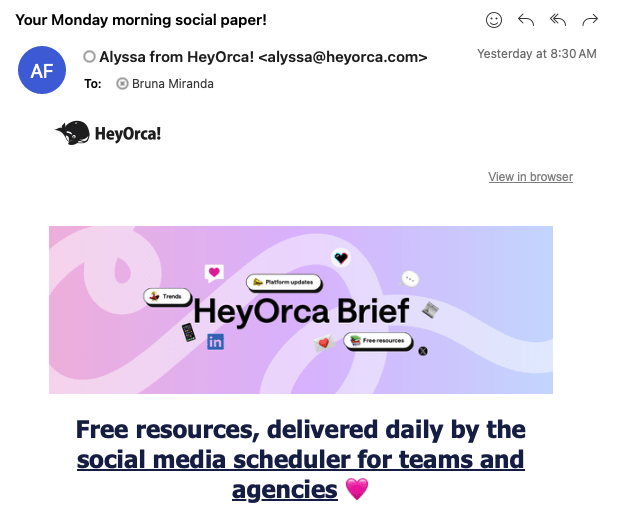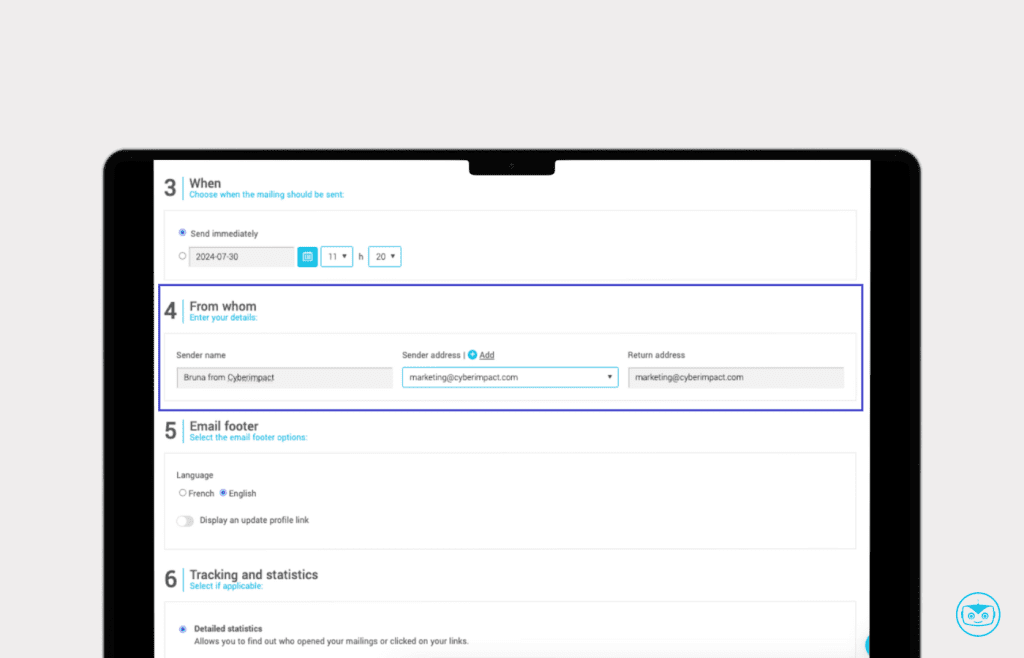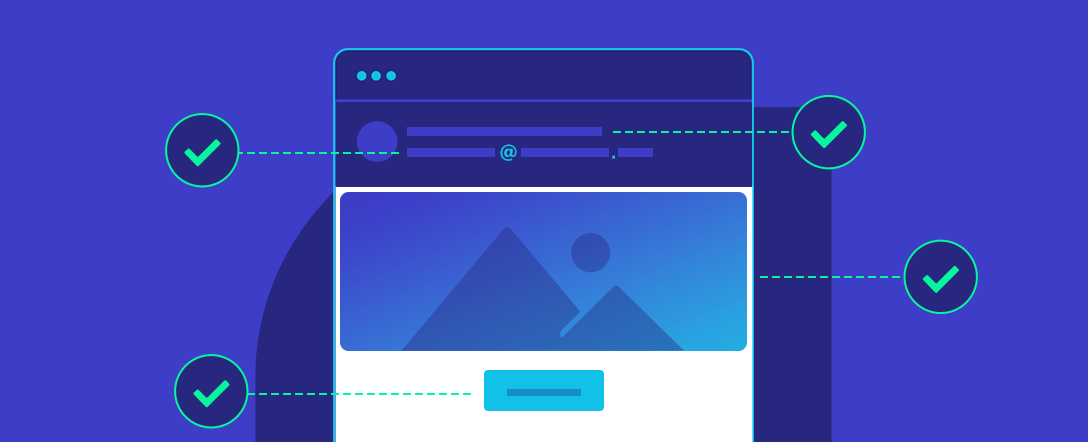Email marketing is a powerful tool for businesses. With the right strategy, you can connect with their audience, drive sales, and build brand loyalty. However, crafting an email that truly resonates with your readers is more than just compelling content.
The email design and structure weigh deeply on its effectiveness. To make your emails stand out and achieve your marketing goals, be sure to include these six essential elements in each email you create. They will help your emails be more effective and engaging for your audience.
First, what is a business newsletter?
A newsletter is an email (or a series of emails) a company sends to their subscribers. It can include relevant content, product announcements, deals, new blog posts etc. It is a great way to reach your audience directly.
1. Personalized Sender Name
Nowadays, people get countless emails every day. Personalization can have a significant impact and is often what decides whether your email is opened or overlooked. Your sender name sets the tone for your message and is the first thing your recipients see. It’s important for creating a good impression.
This simple yet powerful element can significantly influence open rates and engagement. Using a personalized sender name on your newsletter creates a sense of familiarity and trust.
It can also make your brand seem more approachable and genuine — and that there’s a real person behind the message, enhancing the recipient’s experience. Here’s an example of how HeyOrca, a social media scheduler software, does this:

Their newsletter is signed by “Alyssa from HeyOrca!”. The content has a friendly tone that reminds you that there is a person behind the email. This strategy aligns perfectly with the brand’s personality and it works.
How to apply this to your business newsletter:
- Use your first name and company name (e.g., “Bruna from Cyberimpact”) to add a personal touch while maintaining brand recognition.
- Test different sender names to see which ones resonate best with your audience. On the Cyberimpact dashboard, you can choose a different name for each email you send.
- Ensure the sender name is consistent with your brand’s tone and personality.

2. A Good Subject Line
The subject line is arguably the most critical part of your email. It’s the first thing recipients see, and it is a big part of their decision to open your email or scroll past it. A good subject line should do at least one of the following three:
- Pique curiosity: Consider using questions, teasers, or intriguing statements that leave the recipient wanting to know the full story. Also, you can inject humour or clever wordplay into your subject lines to make your emails stand out in crowded inboxes.
- Create a sense of urgency: Emotions drive actions, and tapping into your audience’s emotions can be a powerful way to increase engagement. “Don’t Miss Out” or “Last Chance” can create a sense of urgency that compels recipients to act.
- Offer a clear benefit: Subject lines should be concise and to the point. Aim to convey the main idea of your email in a few words while maintaining clarity. A clear subject line helps recipients quickly understand what your email is about, increasing the likelihood of opening it.
A study by Barilliance in 2021 found that 64% of recipients opened emails due to their subject lines. They are often short, compelling, and relevant to the email’s content. They should give the recipient a reason to open the email while staying true to the brand’s voice.
Avoiding spam triggers
While crafting subject lines, it’s essential to avoid common spam triggers that could land your emails in the junk folder. Here are some tips for your email copy:
- Avoid overused: Words like “Free,” “Win,” or “Discount” are commonly used in spam emails and may trigger spam filters. Instead, focus on crafting unique and genuine messages.
- YOU DON’T NEED EVERYTHING IN ALL CAPS: Using all capital letters in your subject line can come across as shouting and may trigger spam filters. Stick to sentence case or title case.
- Limit special characters: Overusing special characters like exclamation points or dollar signs can also raise red flags with spam filters. Use them sparingly and only when they genuinely enhance the message.
- Be honest and transparent: Ensure that your subject line accurately reflects the content of your email. Misleading subject lines can damage trust with your audience and result in higher unsubscribe rates.
How to apply this to your business newsletter:
- Keep subject lines under 50 characters for optimal display on mobile devices.
- Use action-oriented language and power words to grab attention (e.g., “Discover” or “Exclusive”).
- Consider personalizing subject lines with the recipient’s name or location for added impact. According to Zippia, personalized email subject lines can cause open rates to grow by 50%.
Examples:
Promotion: ? Hot Summer Deals Inside – Up to 50% Off!
Product Launch: Meet Our Latest Release Here!
Webinar Invitation: Join Our Exclusive Webinar – Save Your Spot!
Personalized Greeting: Hey [Name], Here’s a Special Deal for You…
3. Good Preview Text
Your email preview text, also known as a preheader, is the snippet of text that appears next to or below the subject line in an inbox. It provides additional context and serves as a teaser for the email’s content.
Preview text can enhance open rates by complementing the subject line and enticing recipients to read further.
How to apply this to your business newsletter:
- Use the preview text to expand on the subject line, giving the recipients a glimpse of what’s inside your email.
- Keep it concise yet informative. The ideal size is between 40 to 70 characters.
- Avoid repeating the subject line; instead, use the space to offer additional value and convince recipients to open your email.
Example:
Imagine you’re sending an email about a webinar. Your subject line might be “Join Our Free Marketing Webinar!”
The preview text could read, “Reserve your spot now and learn from industry experts.” This provides recipients with a reason to open the email and register for the event.

4. Quality images (but don’t overdo it)
Images can make a world of difference in email design, as they can quickly convey information and evoke emotions. But you need to find the right balance.
A well-placed image can enhance your message, however, an overload of visuals has the opposite effect. It can slow down loading times, impact your email deliverability and distract your target audience from the email’s primary content.
Some brands create image-only emails — similar to a flyer — to share all the information they want with their audience. However, email service providers often view image-only emails as spam activity. Several email clients block image-only emails from reaching users’ inboxes, either by blocking the sender completely or sending the email to the junk/spam folder.
Instead, create a mix of text and images that complement one another. When selecting images, choose high-quality visuals that align with your brand’s aesthetic and complement the written content. Ensure to use images optimized for quick loading and display correctly on all devices.
How to apply this to your business newsletter:
- Use images strategically to highlight key points or products without overwhelming the recipient with information or making the email too long.
- Include alt text for images to ensure accessibility for all and display context if images fail to load. If you have a blog, you might already know how alt text is great for SEO.
- Consider using a hero image at the top of your email to capture attention as soon as people open your message.
Scenario Example:
If you’re a travel agency promoting a new vacation package, include a captivating image of the destination as a hero image. This visual can help your audience see themselves in that location and spark their interest in the offer or content you will share next.

5. Clear Call-to-Action (CTA)
A clear call-to-action (CTA) is an essential component of any successful email marketing strategy. It is the bridge between the email content and the desired action you want your audience to take.
Whether you aim for your recipients to make a purchase, download a resource, or engage with your brand in any other way, a good CTA can significantly impact the effectiveness of your email campaigns.
How to apply this to your business newsletter:
- Use contrasting colours for the CTA button: Choose colours that make the CTA button pop and draw the reader’s eye. Ensure that the colour aligns with your brand identity while providing a stark contrast to other elements in the email.
- Write action-oriented copy: Use clear and compelling language that motivates recipients to take action. Focus on communicating the benefit of clicking, such as “Unlock Exclusive Offers” or “Join Our Community.”
- Position the CTA strategically: Place the CTA in a prominent location within the email, such as above the fold or at the end of a section. Ensure that it’s easily accessible and guides recipients toward the desired action without requiring excessive scrolling.
- Consider adding multiple CTAs: If your email covers multiple topics or offers, consider including multiple CTAs. However, ensure that each one is clear and with a purpose behind it. The goal is to guide recipients toward specific actions without overwhelming them.
Example:
You are promoting an exclusive e-book on digital marketing. Your email might include a CTA button that says “Download Your Free E-book”. Use the most eye-catching colour from your brand colour palette to draw attention to the button, and place it near the email’s main content to increase click-through rates.
6. Unsubscribe Link (Complying with Canadian Email Legislation)
Including an unsubscribe link in your emails is a non-negotiable. According to Canada’s Anti-Spam Legislation (also known as CASL), if you are sending commercial emails, you must…
- Have consent to send that email
- Provide identification information, like a business address.
- Provide an unsubscribe mechanism
Providing an easy way for recipients to opt out is a way to show respect for their preferences and free will. This helps you retain engaged subscribers.
How to apply this to your business newsletter:
- Place the unsubscribe link in a noticeable yet unobtrusive location, typically at the footer of the email.
- Make the process straightforward, with a simple one-click option to unsubscribe.
- Use clear and friendly language, such as “Unsubscribe from future emails” or “Manage your email preferences.”
Conclusion
Personalized sender names, catchy subject lines, informative preview text, balanced imagery, clear CTAs, and unsubscribe options are the building blocks of effective email communication. By incorporating these six essential elements into your email design, you can create compelling emails that capture attention, engage recipients, and drive action.
Remember, email marketing is not a one-size-fits-all approach. Continuously test and refine your strategies to discover what resonates best with your audience. With the right elements in place, your emails can become powerful tools for building relationships and achieving your marketing objectives.
